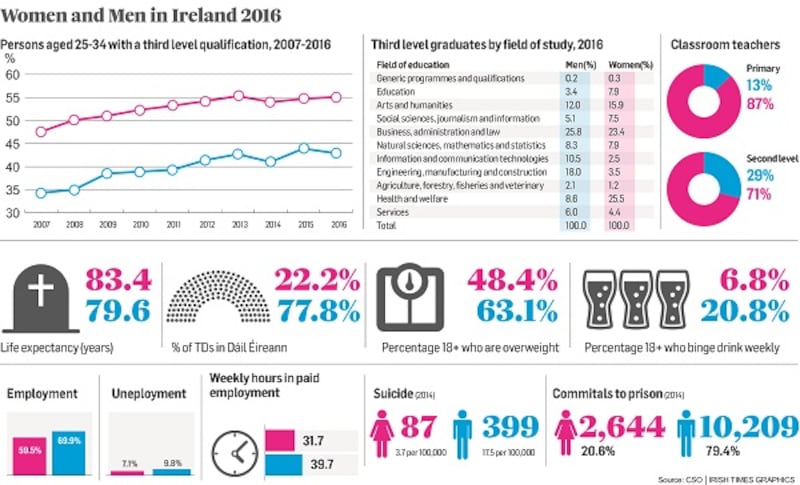Irish people aged 18 to 24 had the highest rates of binge drinking in the European Union, according to the Central Statistics Office (CSO).
The data, released on Wednesday, showed more than a quarter of men and more than 15 per cent of women aged 18 to 24 in Ireland engaged in binge drinking at least once a week in 2014.
Binge drinking is defined as six or more standard drinks in one session, equivalent to three pints of beer or six pub measures of spirits.
Irish women are more likely to have a third-level qualification than men, according to the latest data.

The CSO data showed more than 55 per cent of all women aged between 25 and 34 had a third-level qualification in 2016, compared to 43 per cent of men in the same age group.
The data shows distinct polarisation when it came to the qualifications men and women had attained; more than 80 per cent of graduates in engineering, manufacturing and construction were male last year, and almost 80 per cent who graduated in information and communication technologies were men.
Women represented more than three-quarters of the graduates in health and welfare areas and more than 70 per cent in education.
The graduate differences extended to employment; more than a third of women at work in Ireland in 2016 were working in the health and education sectors. The sectors with the highest proportions of men were construction, agriculture, and transport.
The pattern was also evident at secondary level.
CSO statistician Helen Cahill, said more girls than boys sat higher-level papers in the Leaving Certificate in English, French, Irish, biology, chemistry, art, home economics and music in 2016.
More boys than girls took higher level mathematics, physics, design and communication graphics, construction studies and engineering.
Fewer girls left school early, at almost 5 per cent compared to 8 per cent in men.
The data also showed the vast majority, 98 per cent, of those looking after home and or family last year were women. But the number of men doing such work had risen in the last 10 years, from 4,900 in 2006 to 9,200 in 2016.
Men worked longer hours in paid employment - an average of almost 40 hours a week compared to almost 32 hours for women. They also had a higher rate of employment, at almost 70 per cent compared to almost 60 per cent for women.
Men also had a higher rate of unemployment than women in 2016, almost 10 per cent and 7 per cent respectively.
Ms Cahill said women were significantly under-represented in decision-making structures in Ireland at both national and regional levels. Less than a quarter of TDs in Dáil Éireann were women in 2016, and only just over 20 per cent of local authority members were female.
“The average female representation in national parliaments in the EU in 2016 was 28.7 per cent,” she said.
Ireland was below the EU average for smoking, though, with just under a quarter of males aged 15 and over were smokers in 2014, compared with a fifth of females.
Irish men and women were both above the EU average for obesity and close to two-thirds of men and almost half of women were overweight.
The fertility rate in Ireland, at 1.92, was the second highest rate in the EU in 2015 after France and well above the EU average of 1.58. The average age at which women gave birth to their first child rose from almost 25 in 1975 to 30.5 years in 2014.
Last year, there were 98 men per 100 women in Ireland, though there were more boys than girls. There were fewer men aged 25 to 34 years because more men have emigrated in recent years, according to the CSO report.
At older ages there were more women, because they live longer. A woman’s life expectancy in Ireland was more than 83 years, while a man’s was almost 80.
Data on immigration included in the report showed it peaked in 2007 at 80,000 for men and 71,100 for women.
In 2017, there were 42,700 male immigrants and 41,900 female immigrants, down from a peak of 80,000 and 71,100 in 2007. Emigration peaked at 45,900 in 2012 and had fallen to 34,200 this year.










